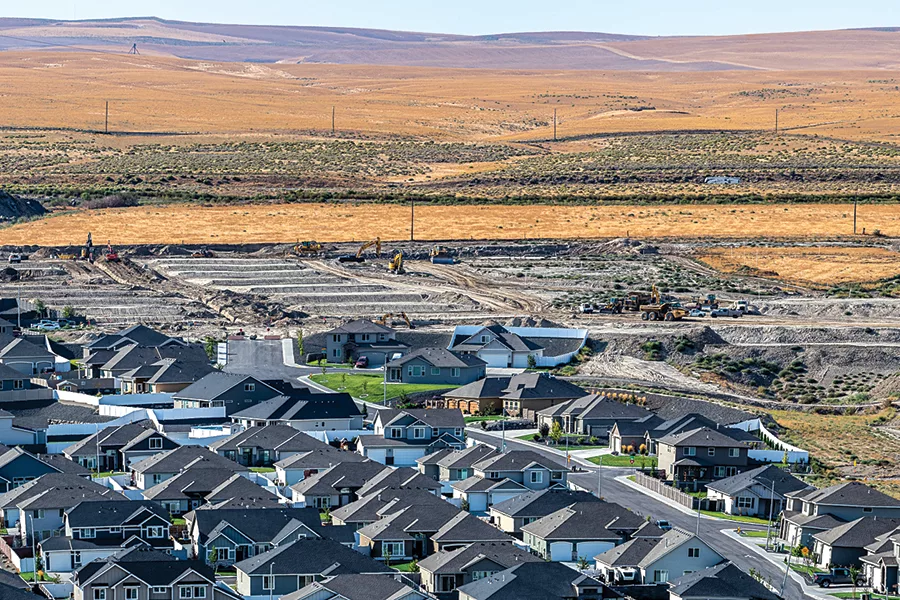
Home » Residential Growth: Tight home supply drives up prices
Residential Growth: Tight home supply drives up prices

October 15, 2021
Homebuilders face familiar headwinds in 2021 – finding enough places to build new homes, hiring enough workers to build them and sourcing enough building materials to build with.
Add in Washington’s new energy code, which took effect this year, and it’s a challenging time to be a residential developer. But the local and regional builders operating in the Tri-Cities are finding ways to press ahead.
Despite the many ways projects can go sideways, homebuilders managed to pull more permits in the first eight months of 2021 – 1,200 – than in the same period for the five years prior, including the record-busting pre-pandemic year 2019.
Pasco, among the region’s fastest-growing cities, led the way with 296, followed by Richland (269), West Richland (206) and Kennewick (171).
The rising numbers reflect a unique but not temporary moment for the Tri-Cities. A history of underbuilding here and across the U.S. means there are too few homes to accommodate a population that passed the 300,000 mark in 2020, according to U.S. Census Bureau estimates.
New construction and “resales” – the industry term for the sale of previously owned homes – sell almost immediately. The average time on the market is under 10 days.
Inventory is measured in fractions of a month. In a healthy market, brokers like to see enough listings to satisfy current demand for five to six months. Locally, 1,200 listings is considered the sweet spot for a balanced market.
In June, there were just 206 homes for sale.
Buyer frustration
The short supply is driving up prices and leading to bidding wars, a frustrating situation for buyers.
The combination gives homebuilders little room to navigate, said Jeff Losey, executive director of Home Builders Association of Tri-Cities, which tracks building permits in Benton and Franklin counties. Figures for Burbank, in Walla Walla County, are not included.
While rising prices – new homes now cost an average $486,000 – offer builders some breathing room, supply chain issues disrupt schedules and contracts.
Losey said builders have less control over their final costs or even when a home will be finished.
For buyers, that means less choice. Builders aren’t pre-selling homes before they build them, a practice that lets buyers customize layouts, appliance packages, paint schemes and make other personal touches.
Early in the pandemic, builders had to honor pre-sale contracts and saw profits disappear as lumber and other material costs soared.
“What we’re seeing is a propensity to not sell until it’s nearly finished, and final costs are known,” he said. “The builders don’t have the luxury of selling it and acquiescing to what the buyer wants.”
Waiting has another benefit. It ensures non-cash buyers qualify for mortgages.
If a buyer qualifies for a $500,000 mortgage early in the process and the final cost rises by $30,000, there’s no guarantee a lender will raise the loan amount.
Hot housing market
The rapid pace appears to be drawing the Tri-Cities to the attention of national builders, who aren’t currently active here. D.R. Horton, a leading national builder with offices in Seattle, Spokane and Vancouver, is eyeing building sites in the Tri-Cities, Losey said.
D.R. Horton didn’t acknowledge a request for comment.
“We might have our first national builder coming in soon,” Losey said.
 Future home sites form a giant staircase up the south side of Little Badger Mountain.
Future home sites form a giant staircase up the south side of Little Badger Mountain.
The Heights at Red Mountain Ranch, the 789-home subdivision in West Richland by Aho Development, is the region’s hottest construction zone. The city issued 206 single-family permits in the first eight months of 2021, compared to 70 in the same period in 2020.
In Kennewick, development is extending beyond the Southridge area along Bob Olson Parkway, while Pasco is starting to see homes built in the newly opened Broadmoor area, west of Road 100-Broadmoor Boulevard.
The area’s cities and counties are under pressure to approve new subdivisions, Losey said.
“The National Association of Home Builders has been saying for years that we’ve been underbuilding. That underbuilding is coming home to roost,” he said.
Challenges stack up
Washington’s new energy code, which was implemented in February, is another unwelcome challenge. The Building Industry Association of Washington (BIAW), which has asked Gov. Jay Inslee to suspend it until April 2022, said the tight new codes add $15,000 to $20,000 to the price of a new home.
The problem is exacerbated by delays in getting supplies, a problem that affects everything from furnace and heat pumps to windows, insulators and electrical service panels.
“Homes are more important than ever. Providing relief from these changes will help stabilize the supply chain and save current homebuyers tens of thousands of dollars,” said Tracy Doriot, president of BIAW and a homebuilder.
For the Realtors tasked with selling new and existing homes, the supply-demand imbalance is on painful display, said Lola Franklin, CEO of the Tri-City Association of Realtors.
Franklin recalls asking a casual question during a recent member meeting: Who received the most offers on a single listing?
The winning answer: 27.
“All the things we thought would slow down or stop during Covid did the opposite,” she said, calling the past year the busiest she’s seen in her 10 years with the organization.
Realtors are grateful to homebuilders for adding to the inventory, but the market remains tight and it’s going to get even tighter.
At least 3,000 new jobs are coming to the Tri-Cities, courtesy new food processing plants planned for Darigold Inc., Reser’s Fine Foods and Local Bounti, as well as two Amazon Inc. distribution centers that will begin hiring in 2022.
In a tight housing market, job growth linked to the new plants and other developments (like the new Costco in Pasco) will skew the supply-demand imbalance even further.
“It’s not a crisis, but it is cause for alarm,” Franklin said. “Everyone is leaning on builders to build as fast as they can.” l
Construction + Real Estate
KEYWORDS october 2021





